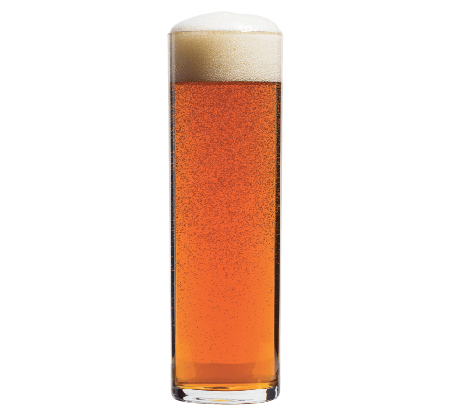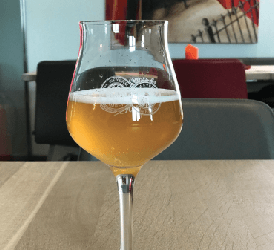Düsseldorf Altbier
Altbier
(5 gallon/19 L, all-grain)
OG = 1.047 FG = 1.011
IBU = 40 SRM = 15 ABV = 4.7%
The grain bill of the classic copper-colored altbier — which is internationally also known as a German Brown Ale — is almost Munich-like, but with a slightly less “caramelly” character than a Märzen, and less dark than a dunkel. It differs from a Munich brew, however, in its much more pronounced hoppiness. This creates a wonderful blend of malt-and-hop aromas in the finish, which is often described as bitter-sweet. The uniqueness of this beer — an ale after all — comes from the clean fermentation of a relatively cold-tolerant, top-fermenting specialty yeast.
Ingredients
5.5 lbs. (2.5 kg) German Munich I malt
2.33 lbs. (1.05 kg) continental Pilsner malt
2 lbs. (900 g) Weyermann Carared® malt (17 °L)
3.2 oz. (90 g) Weyermann Carafa® Special I malt (338 °L)
7.6 AAU Spalt hops (60 min.) (1.9 oz./53 g at 4% alpha acids)
4.4 AAU Spalt hops (10 min.) (1.1 oz./32 g at 4% alpha acids)
Wyeast 1007 (German Ale) or White Labs WLP036 (Düsseldorf Alt) or Safale K-97 yeast
3⁄4 cup corn sugar (if priming)
Step by Step
This is a multi-step mash. Crush grains and mash in at 122 °F (50 °C). Rest 15 min. Raise the temperature to 147 °F (64 °C) and rest 15 minutes. Raise the temperature to 162 °F (72 °C) and rest 15 minutes. Raise the temperature for the mash-out to 171 °F (77 °C). Recirculate, then begin sparge.
Boil for 75 minutes, adding hops as indicated. Turn off heat and whirlpool 15 minutes. Heat-exchange to the mid-range of the temperature tolerance of the selected yeast strain. This range is often between 54 °F and 68 °F (12 °C and 20 °C). Ferment for about 7 days. At a gravity of roughly 1.014 to 1.017, raise the tank temperature for a 2-day diacetyl rest to approximately 66 °F (19 °C).
For a secondary fermentation, lower the temperature again to the yeast’s mid-range. After 5 additional days, purge the sedimented yeast and debris. Transfer the brew to a capped conditioning tank. Lager for 3 weeks at about 36 °F to 25 °F (2 °C to -4 °C). Adjust the carbonation to approximately 2.2 to 2.6 volumes of CO2. Package filtered or unfiltered.
Altbier
(5 gallon/19 L, extract with grains)
OG = 1.047 FG = 1.011
IBU = 40 SRM = 15 ABV = 4.7%
Ingredients
3.3 lbs. (1.5 kg) Munich liquid malt extract
1.5 lbs. (0.68 kg) Pilsen dried malt extract
2 lbs. (0.9 kg) Weyermann Carared® malt (17 °L)
3.2 oz. (90 g) Weyermann Carafa® Special I malt (338 °L)
7.6 AAU Spalt hops (60 min.) (1.9 oz./53 g at 4% alpha acids)
4.4 AAU Spalt hops (10 min.) (1.1 oz./32 g at 4% alpha acids)
Wyeast 1007 (German Ale) or White Labs WLP036 (Düsseldorf Alt) or Safale K-97 yeast
3⁄4 cup corn sugar (if priming)
Step by Step
Start with 5 gallons (19 L) brewing water in your pot. Steep the crushed grains placed in a muslin bag as the water heats up to 170 °F (77 °C).
Remove the grain bag, allowing the liquid to drip back into the pot. Remove from heat and stir in all the malt extract. Turn heat back on once all the extract is dissolved and bring wort to a boil. Boil for 60 minutes, adding hops as indicated.
At the end of the boil, turn off heat and whirlpool for 15 minutes. Heat-exchange to the mid-range of the temperature tolerance of the selected yeast strain. This range is often between 54 °F and 68 °F (12 °C and 20 °C). Ferment for about 7 days. At a gravity of roughly 1.014 to 1.017, raise the tank temperature for a 2-day diacetyl rest to approximately 66 °F (19 °C).
For a secondary fermentation, lower the temperature again to the yeast’s mid-range. After 5 additional days, purge the sedimented yeast and debris. Transfer the brew to a capped conditioning tank. Lager for 3 weeks at about 36 °F to 25 °F (2 °C to -4 °C). Adjust the carbonation to approximately 2.2 to 2.6 volumes of CO2. Package filtered or unfiltered.
Written by Horst D. Dornbusch

The grain bill of the classic copper-colored altbier — which is internationally also known as a German Brown Ale — is almost Munich-like, but with a slightly less “caramelly” character than a Märzen, and less dark than a dunkel. It differs from a Munich brew, however, in its much more pronounced hoppiness. This creates a wonderful blend of malt-and-hop aromas in the finish, which is often described as bitter-sweet. The uniqueness of this beer — an ale after all — comes from the clean fermentation of a relatively cold-tolerant, top-fermenting specialty yeast.



